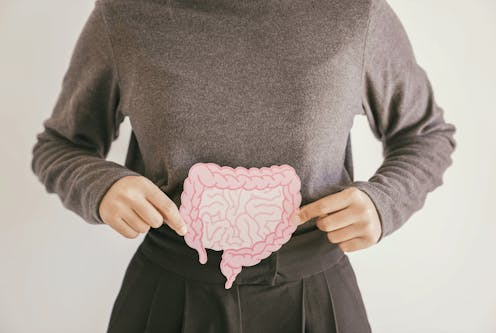
Lactate will be familiar to many due to a common belief that it causes muscle “burn” following exercise – but this is a myth.
Lactate is formed in our muscles during exercise, but this is not the only source of it in our bodies. It is also produced by many of the microbes that live in our gut as they grow.
In the gut, lactate has several important roles. Some of these are beneficial. For example, it is produced by bifidobacteria that dominate in the colon of breast-fed infants. Scientists think that this lactate helps protect the infant by making the gut more acidic, which can impede the growth of some harmful bacteria.
In other situations, though, the acidifying effect of lactate can severely harm the wider gut microbiome and the health of the host human – or animal.
This is most clearly seen in livestock, such as cattle, where lactate accumulation can make the gut too acidic, leading to a condition called lactic acidosis. This kills off swathes of beneficial gut bacteria and leads to further accumulation of lactate in the gut.
In severe cases, this can lead to the death of the animal, since lactate can be toxic in high concentrations.

Lactate accumulation in the gut of humans is also associated with poor health. Thankfully, the sort of gut-derived lactic acidosis that occurs in ruminant livestock is much rarer in humans, but can occur in people with short-bowel syndrome (the name is self-explanatory).
Increasing lactate concentrations in the colon are also associated with disease severity in people suffering from inflammatory bowel diseases.
Lactate-induced killing of protective gut microbiome species may also favour the growth of harmful bacteria, such as Salmonella and Campylobacter. These pathogens can also feed on lactate themselves if there are not high concentrations to inhibit this, giving them a further growth advantage.
Lactate-utilising bacteria
Fortunately, lactate tends not to accumulate in the gut of healthy adults, despite the fact it is produced by a range of different gut bacteria. This is because the gut microbiome contains several microbes, collectively termed “lactate-utilising bacteria”, that are able to grow on and gain energy from lactate, and in the process convert it into other things.
One of the most interesting lactate-utilising bacteria is called Anaerostipes hadrus. This microbe is so well adapted to growth on lactate that it will still use it effectively even when also provided with other energy sources, such as glucose.
Another key feature of Anaerostipes hadrus is that it converts lactate into a short-chain fatty acid called butyrate. Butyrate is generally thought of as highly beneficial as it is absorbed and used by the human cells that line the colon, providing them with up to around 70% of their energy needs.
By feeding our gut cells, it helps them to grow and function optimally, strengthening our gut barrier against invading harmful microbes. Butyrate also appears to be anti-inflammatory, helping to dampen down excessive or damaging immune reactions in our gut. There is even some evidence that it may have a protective role against colorectal cancer.
Lactate-utilising bacteria, such as Anaerostipes hadrus, as well as other butyrate-producing types including Anaerobutyricum species and Eubacterium limosum, can therefore be thought of as doubly advantageous, given that they remove the potentially harmful lactate from the gut and simultaneously convert it into beneficial butyrate.
The potential importance of these lactate-utilising bacteria for health was further hinted at in a study published in 2021, which showed that Anaerostipes species were commonly reduced in the guts of people with a range of different diseases.
For these reasons, there is emerging interest in developing lactate-utilising bacteria as probiotics. However, testing in humans is still needed to prove that they will work.
These bacteria are typically highly sensitive to oxygen, meaning they are more difficult to grow and package than traditional probiotics, so may be more challenging to develop into therapies. Still, they hold much promise, and by removing lactate, probably play an important role in maintaining gut health.
Alan Walker receives core research funding from the Scottish Government’s Rural and Environment Science and Analytical Services Division (RESAS). He also works on research projects funded by the UKRI Global Challenges Research Fund, the European Commission, Innovate UK, EnteroBiotix Ltd and ZOE Ltd. He currently consults for EnteroBiotix Ltd, and has previously consulted for ZOE Ltd. None of these funders had any input into this article, and exerted no influence on the content.
This article was originally published on The Conversation. Read the original article.







